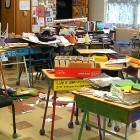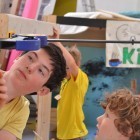"One overriding challenge is now coming to the fore in public consciousness: We need to reinvent just about everything. Whether scientific advances, technology breakthroughs, new political and economic structures, environmental solutions, or an updated code of ethics for 21st century life, everything is in flux—and everything demands innovative, out of the box thinking."
Get Started for FREE
Sign up with Facebook Sign up with X
I don't have a Facebook or a X account
 Your new post is loading... Your new post is loading...
 Your new post is loading... Your new post is loading...
|

Lucy Robertson's curator insight,
October 22, 2014 8:26 PM
Inquiry: the best teachers show you where to look, don't tell you what to see. Inquiry learning helps students across all curriculum areas. 
Elizabeth Galo's curator insight,
August 26, 2015 7:11 AM
A few things about this article stand out, firstly that inquiry is fostered through scaffolding, secondly, that teachers teach kids - not subjects and finally that opportunities are provided for experiential learning. Scaffolding learning enhances the learning experience for all students, as the amount of scaffolding required can be differentiated. When teachers let go of their need to teach subjects, or impart knowledge they are free to facilitate a learning process. There is a great body of research to suggest that students learn best through a hands-on experiential approach. Providing these opportunities throughout the day challenges teachers to forsake the commonplace and allow for richer, less contrived learning spaces.

HND Assignment help's curator insight,
November 18, 2015 10:31 PM
Innovation at classroom can be obtained through our assignment help services at http://assignmenthelpblog.blogspot.in/
hndassignmenthelp@gmail.com |















What comes to mind when you think of the word innovation? And if we apply innovation in education what are your thoughts? The Common Core informs us that we should be teaching creativity, curiosity, critical thinking, and more. If we look at innovation we meet these criteria. This post provides 10 ideas. Many of the ideas on the post provide links to additional resources.
* Teach concepts, not facts.
* Distinguish concepts from critical information.
* Make skills as important as knowledge.
* Use creativity tools.